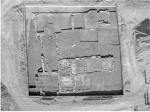Summary (English)
Archaeological intervention in this site was included in the project of cultural heritage impact mitigation for the MU- 603 road which unites the MU-602 and Mazarrón highway. This program was set up by The Directorate of Arts and Cultural Property.
This Roman site is classified on the Carta Arqueológica Regional. Previous studies had shown these works would endanger the site. The bespoke program aimed at defining the limits of evidence in the surface and determine their features. This intervention has been carried out only at a surface level. An average surface of 400 m on approach, with a perpendicular width of 20 m was examined by 36 coring tests. They were carried out systematically, at 20 metres intervals, and located along a previously-implemented axis. An overview of the archaeological assets of the area was provided by these drillings’ tests.
Four of them found levels belonging to a Roman Villa, Then, an open-air excavation wasscheduled on a surface of 650 square meters. The work allowed the identification of the remains of a rural settlement, from the early imperial period (2nd Century). Some of the rooms were occupied again in the late Roman period (5th Century). Geologically speaking, the villa was constructed in a Quaternary area in the meadow forming Sangonera’s river valley. Within the cumulative stratigraphic register there are two levels: The first one, the agricultural level, consists of a sedimentary unit. In this context pieces of tegulas and imbrices as well as few pieces of potteries were found. The second one seems to consist of orange clay soil linked to the collapse of the walls.
Most of the rooms were paved with opus signinum. A symmetrical distribution of rooms was found, centering around a large patio. The northern rooms were higher than the others. The villa was entered through a hall that ran straight to the patio. Some fragments of architectural terracottas suggest that they ornamented the the main façade .
Finds included tableware (South Gaullish and African sigillata), cooking wares, amphorae, glass containers, metallic objects (nails, spearheads, knife blades, needles and toilet supplies).
An embankment is going to be built to divide the highway core, so most of the western zone, the least well- preserved of the villa, will be covered. Since Venta de Aledo shows continuation with western rooms, we propose that all of the structures be covered by a layer of geotextile. Then a fine sterile sand layer would cover the whole elevation. This would protectstructures, and enable future archaeological research.
(translation by Aroa Masa Corral)
- Consuelo Martínez Sánchez y Alicia Soler López
Director
- Alicia Soler López
Team
- Consuelo Martínez Sánchez
Research Body
- Arqueotec, S.L.
- Dirección General de Bienes Culturales. Consejería de Turismo y Cultura. Región de Murcia






![Download [PDF]](/excavation/skins/fasti/images/results/download_sml.png)